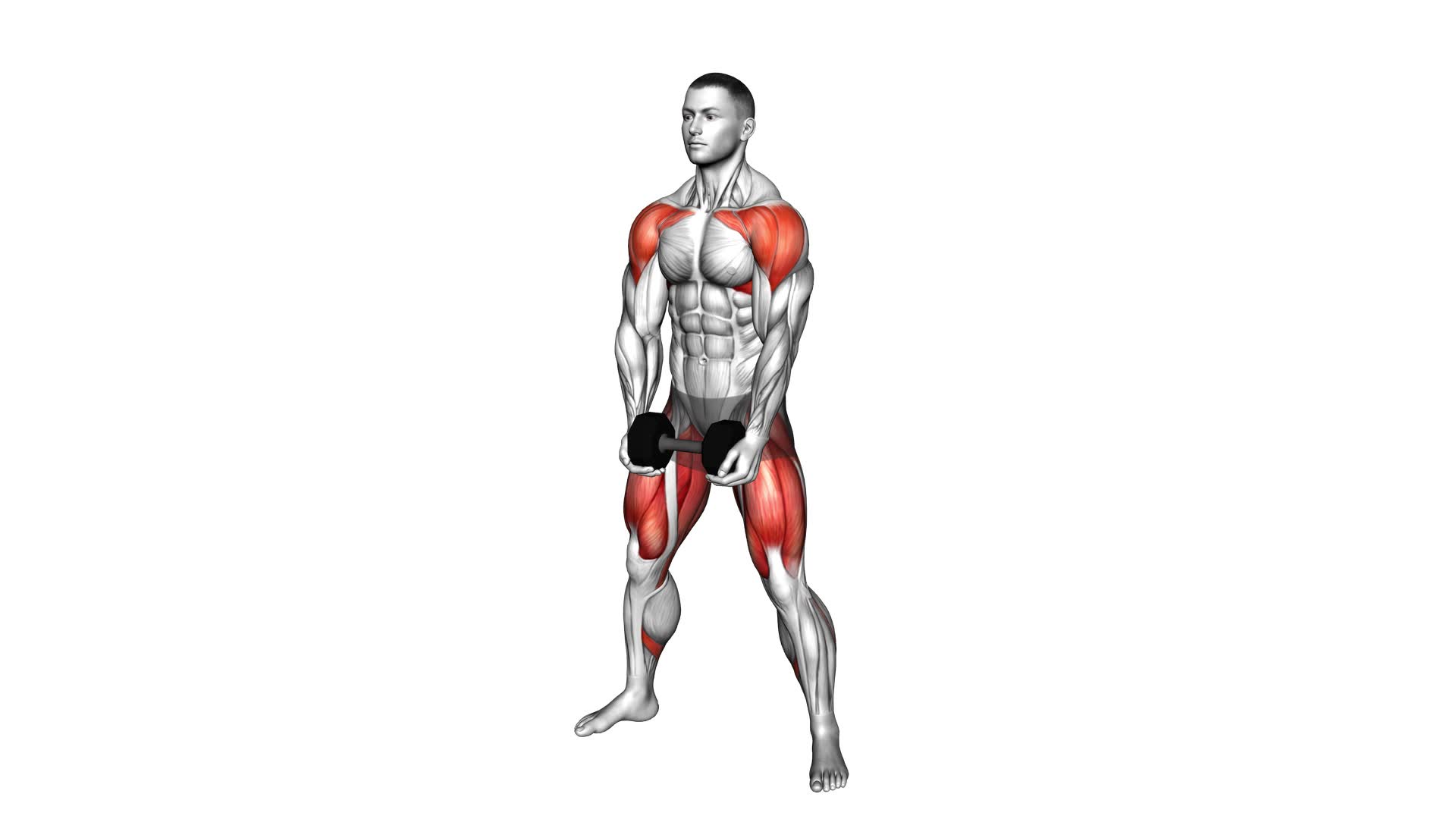Dumbbell Sumo Squat Front Raise (male) – Video Exercise Guide & Tips

Looking to build strength in your lower body and shoulders? The dumbbell sumo squat front raise is the exercise for you.
Watch This Exercise Video
This compound movement targets your quads, glutes, and deltoids, giving you a full-body workout.
In this video exercise guide, we'll show you the proper form and technique, variations to challenge yourself, common mistakes to avoid, and tips for incorporating this exercise into your workout routine.
Get ready to take your fitness to the next level!
Key Takeaways
- Dumbbell Sumo Squat Front Raise improves shoulder strength and enhances upper body strength.
- It targets multiple muscle groups simultaneously, including the quads, glutes, hamstrings, shoulders, and core muscles.
- Maintaining proper form and technique is essential for maximum effectiveness and to avoid common mistakes such as rounding the back or using excessive momentum.
- Modifications and variations can be made to increase or decrease the intensity of the exercise, such as using lighter dumbbells, incorporating jumps, or using alternative equipment like kettlebells or resistance bands.
Benefits of the Dumbbell Sumo Squat Front Raise
To maximize your workout, the dumbbell sumo squat front raise offers a multitude of benefits. This exercise is highly effective in improving your shoulder strength and increasing lower body stability. By incorporating dumbbells into the sumo squat, you're engaging multiple muscle groups simultaneously, resulting in a more efficient and effective workout.
The dumbbell sumo squat front raise specifically targets your shoulder muscles, including the deltoids and trapezius. As you perform the squat, the front raise motion engages these muscles, helping to improve their strength and definition. This exercise is especially beneficial for individuals looking to enhance their upper body strength and develop toned shoulders.
In addition to targeting the shoulders, the sumo squat aspect of this exercise also works the lower body. The wide stance and squatting motion engage the glutes, quadriceps, hamstrings, and calf muscles, leading to increased lower body stability. This is particularly advantageous for athletes or individuals looking to improve their balance and overall lower body strength.
Proper Form and Technique for the Exercise
To perform the dumbbell sumo squat front raise with proper form and technique, you need to start by standing with your feet shoulder-width apart and holding a dumbbell in each hand. This exercise targets the lower body, particularly the quads, hamstrings, and glutes, while also engaging the shoulders and core.
To begin, position the dumbbells in front of your thighs, palms facing your body. Engage your core and lower your body into a squat position. Keep your back straight, chest lifted, and knees tracking over your toes. Make sure your weight is evenly distributed between both feet.
As you rise from the squat position, exhale and simultaneously lift the dumbbells in front of you until they reach shoulder level. Your arms should be extended straight in front of your body, parallel to the ground. Hold this position for a moment, then lower the dumbbells back down to the starting position as you inhale.
Common errors to avoid include rounding your back, letting your knees cave inward, and using excessive momentum to lift the dumbbells. It's important to maintain control throughout the movement and focus on engaging the target muscles.
Modifications for this exercise include using lighter dumbbells or starting with bodyweight squats if you're a beginner. As you become more advanced, you can increase the weight of the dumbbells to continue challenging your muscles.
Remember to always consult with a fitness professional before attempting any new exercise, especially if you have any pre-existing medical conditions or injuries.
Variations to Make the Exercise More Challenging
To increase the difficulty of the exercise, try incorporating a jump into the dumbbell sumo squat front raise. This advanced modification adds an explosive element to the movement, engaging more muscle groups and boosting your overall strength and power.
To perform this variation, start by standing with your feet wider than shoulder-width apart and hold a dumbbell in each hand, palms facing your body. Squat down into a sumo squat position, keeping your chest up and your core engaged.
As you rise up from the squat, push through your heels and explode off the ground, jumping as high as you can while simultaneously raising the dumbbells in front of you until they reach shoulder height.
Land softly back into the sumo squat position and repeat the movement for the desired number of reps. This variation not only challenges your lower body strength but also adds a cardiovascular component to the exercise.
If you don't have access to dumbbells, you can use alternative equipment such as kettlebells or resistance bands to add resistance to the movement.
Remember to maintain proper form to prevent injury and maximize the benefits of this challenging variation.
Common Mistakes to Avoid
One common mistake to avoid when performing the dumbbell sumo squat front raise is letting your knees collapse inward during the squat. This is a common error that can put unnecessary strain on your knees and potentially lead to injury.
To ensure proper technique and avoid this mistake, keep the following tips in mind:
- Maintain proper alignment: Throughout the movement, make sure your knees are tracking in line with your toes. This helps distribute the load evenly and prevents excessive stress on your joints.
- Engage your glutes and core: By activating your glutes and core muscles, you create a stable foundation for the exercise. This helps maintain proper form and prevents your knees from collapsing inward.
- Control the descent: When lowering into the squat, focus on controlling the movement and keeping your knees in line with your toes. Avoid rushing through the exercise, as this can lead to poor form and increased risk of injury.
- Use appropriate weight: It's important to choose a weight that allows you to maintain proper form throughout the exercise. If the weight is too heavy, you may be more likely to let your knees collapse inward. Start with a lighter weight and gradually increase as your strength improves.
Tips for Incorporating the Exercise Into Your Workout Routine
To incorporate the dumbbell sumo squat front raise into your workout routine, focus on proper form and gradually increase the weight as you build strength. This exercise is a compound movement that targets multiple muscle groups, including the lower body, core, and shoulders.
For beginners, it's important to start with lighter weights and master the proper technique before progressing to heavier weights. You can also modify the exercise by using just body weight or holding a single dumbbell instead of two. This will help you build a solid foundation and prevent any potential injuries.
To increase the intensity of the exercise, you can gradually increase the weight of the dumbbells as you become stronger. This will challenge your muscles and help you make progress over time. Additionally, you can increase the number of reps or sets you perform, or even incorporate supersets or dropsets to make the workout more challenging.
Remember to always listen to your body and only increase the weight or intensity when you feel ready. It's also important to warm up properly before performing this exercise to prevent any strains or injuries.
Frequently Asked Questions
How Many Sets and Reps Should I Do for the Dumbbell Sumo Squat Front Raise?
For the dumbbell sumo squat front raise, it's important to focus on proper form and technique.
Start by standing with your feet wide apart and toes pointing outwards. Hold a dumbbell in each hand.
Lower your body into a squat position, keeping your back straight and knees in line with your toes.
As you rise up, raise the dumbbells in front of you until they're at shoulder level.
Aim for 3-4 sets of 10-12 reps to effectively target your lower body and shoulders.
Can I Perform the Dumbbell Sumo Squat Front Raise Without Using Dumbbells?
Yes, you can perform the dumbbell sumo squat front raise without using dumbbells. There are alternative exercises you can do to work similar muscle groups, such as bodyweight sumo squats or kettlebell front raises.
However, using dumbbells in the exercise provides added resistance, which can help increase muscle strength and definition. The benefits of using dumbbells include targeting specific muscle groups, improving stability, and increasing overall strength.
Is the Dumbbell Sumo Squat Front Raise Suitable for Beginners?
The dumbbell sumo squat front raise is a great exercise for beginners. It helps to strengthen your lower body and improve your posture.
If you're just starting out, you can modify the exercise by using lighter dumbbells or even just your body weight. This will allow you to focus on getting the form right and gradually increase the intensity as you get stronger.
Don't forget to warm up properly and consult a fitness professional if you have any concerns.
Can the Dumbbell Sumo Squat Front Raise Help in Building Leg Muscles?
The dumbbell sumo squat front raise is a great exercise for building leg muscles. By incorporating this exercise into your workout routine, you can target your quads, hamstrings, and glutes. It also engages your core and upper body muscles, providing a full-body workout.
To maximize the benefits, make sure to maintain proper form and technique. Keep your back straight, knees aligned with toes, and lift the dumbbells with control. This exercise can help you achieve stronger and more defined legs.
Are There Any Modifications for Individuals With Knee or Back Problems While Performing the Dumbbell Sumo Squat Front Raise?
If you have knee or back problems, there are modifications you can make while performing the dumbbell sumo squat front raise.
For knee problems, you can use lighter weights or eliminate the front raise altogether.
To protect your back, focus on maintaining proper form and avoid lifting too heavy.
The dumbbell sumo squat front raise is a great exercise for overall strength and stability, so it's important to find modifications that work for you.
Conclusion
Incorporating the dumbbell sumo squat front raise into your workout routine can bring numerous benefits. This exercise targets the lower body and shoulder muscles, helping to build strength and improve overall stability. By maintaining proper form and technique, you can maximize the effectiveness of the exercise and avoid common mistakes.
Additionally, you can make the exercise more challenging by incorporating variations. So, add this exercise to your routine and enjoy the benefits it brings to your fitness journey.

Author
Years ago, the spark of my life’s passion ignited in my mind the moment I stepped into the local gym for the first time. The inaugural bead of perspiration, the initial endeavor, the very first surge of endorphins, and a sense of pride that washed over me post-workout marked the beginning of my deep-seated interest in strength sports, fitness, and sports nutrition. This very curiosity blossomed rapidly into a profound fascination, propelling me to earn a Master’s degree in Physical Education from the Academy of Physical Education in Krakow, followed by a Sports Manager diploma from the Jagiellonian University. My journey of growth led me to gain more specialized qualifications, such as being a certified personal trainer with a focus on sports dietetics, a lifeguard, and an instructor for wellness and corrective gymnastics. Theoretical knowledge paired seamlessly with practical experience, reinforcing my belief that the transformation of individuals under my guidance was also a reflection of my personal growth. This belief holds true even today. Each day, I strive to push the boundaries and explore new realms. These realms gently elevate me to greater heights. The unique combination of passion for my field and the continuous quest for growth fuels my drive to break new ground.







